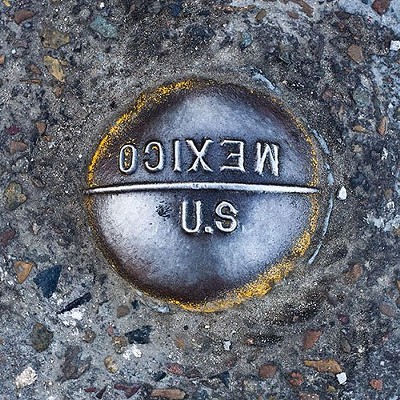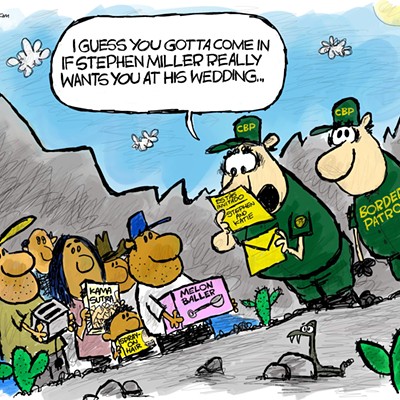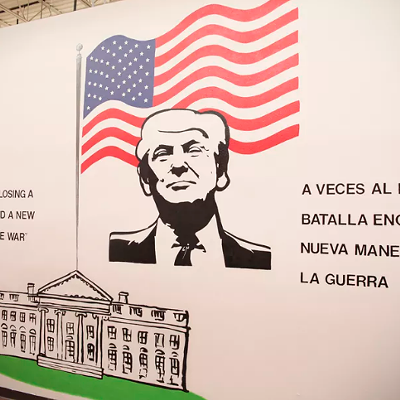Dan Wirth and Keith Graves spent significant portions of their careers working on the Arizona-Mexico border. They know these troubled lands inside and out. Both have reputations as straight-shooters, and both retired last December.
Now able to speak freely, they agreed to talk to the Tucson Weekly with only one topic off-limits—the murder of Border Patrol agent Brian Terry in Peck Canyon on Dec. 14, 2010. At his retirement, Graves promised the Border Patrol he wouldn't discuss what he knows about the case.
Graves was the Nogales district ranger for the Coronado National Forest from 1998 to 2010. When he left that post, he was named a liaison between the Forest Service and the Secure Border Initiative, focusing on strategies for dealing with the dramatic impact that illegal crossings were having on the forest, from fires to trash to illegal trails.
Wirth was a senior special agent for the Department of Interior. He coordinated the department's law-enforcement activities across the Southwest, giving frequent briefings to the secretary of the interior, the Office of National Drug Control Policy, the Department of Defense, the White House Homeland Security Council and members of Congress.
We met at a quiet Mexican restaurant in Barrio Hollywood, on Tucson's westside. The discussion began with a dust-up last May, when Homeland Security Secretary Janet Napolitano appeared before the Senate Homeland Security Committee. Sen. John McCain asked her about cartel scouts, or spotters—armed men who sit on mountaintops in Arizona to guide loads around law enforcement.
The senator wanted to know how Napolitano could call the border secure when there are 100 to 200 cartel spotters working in our state. Napolitano disputed his assertion, saying she asked the Border Patrol, "Where are the spotters that I keep hearing about?" She said the agency told her there are a couple of hundred mountaintops from which a spotter could work, "But there are not, sitting there, 200 drug-spotters."
The truth is that McCain greatly understated the problem.
Prior to the hearing, Wirth and McCain flew over the Interstate 8 smuggling corridor. This route crosses the Tohono O'odham Nation; goes through the Sonoran Desert National Monument in the Vekol Valley, or crosses farther east through the Bureau of Land Management's Ironwood Forest National Monument; and jumps Interstate 8 into Phoenix—a trek of more than 150 miles, given that it cannot be traveled in anything close to a straight line.
Wirth told McCain there were 75 to 100 scouts working this smuggling corridor alone. Based on that, the senator calculated there are 100 to 200 scouts working along the entire Arizona border.
"But that's a gross underestimate," Wirth says. "There are many more than that."
And the secretary? "Napolitano doesn't want to admit it, but there are drug scouts all over the high ground," Wirth says.
Dan, estimate the number of scouts working in Arizona right now.
WIRTH: I can't, because they fluctuate. They move when a load moves. After the hearing, I called McCain's chief of staff and used the example of the Coronado National Memorial near Sierra Vista, which is very small. It has 3 1/2 miles of border with Mexico. ... There are 18 sites these scouts occupy when they move a load. We have them GPS'd. Extrapolate out across Arizona, and we're talking significantly more than 200.
GRAVES: There used to be three good drug corridors through the memorial. And there are at least six on the Coronado National Forest. In the Peloncillo Mountains on the Arizona-New Mexico line near Douglas, there have to be at least that many more. Each probably has 100 scouts to get a load up to Interstate 10. They need line-of-sight capability, because there is no good cell coverage out there.
WIRTH: They have campsites, stoves, night-vision gear.
GRAVES: If they're coming back carrying weapons and money, they have the same scouting capability. If you're bringing a load up, they might tell you to wait for a day after it's picked up, because someone is coming to give you money to return south.
WIRTH: The cartels have a logistics network running all through the state of Arizona. People buy supplies at Walmart and hike it in—food, batteries for radios, whatever they need.
GRAVES: They have better communications than Border Patrol.
WIRTH: They keep eyes on the load the whole time it moves. They hand it off from one scout to the next, communicating by radio, and they say when to stop, when to go, where law enforcement is. It's very strategic, very organized.
Are these men dangerous?
GRAVES: Only if I walk up to one, reach for a weapon, and say, "Drop what you've got; I'm taking over." Yes, they would kill me.
WIRTH: They work for an international business. And they do what's good for business. They're under orders not to shoot at citizens or law-enforcement people who come up on them, because they can't afford it.
How do we explain the Rob Krentz murder?
WIRTH: That was an isolated incident, the exception. He ran into an hombre.
Do you suspect it was a scout? Cochise County Sheriff Larry Dever says he has evidence it was a drug scout, and I believe Dever.
WIRTH: It's very probable.
Are these resupply people from Mexico or this country?
WIRTH: Both.
GRAVES: The last time I had intel from Homeland Security, they informed me that more people work for the cartels inside the United States than in Mexico.
When Napolitano acts surprised and says, "Gee, where are all these spotters I keep hearing about?" is that political, or does she really not know?
WIRTH: She has to know.
Why is it so difficult to run these scouts off and keep them off?
WIRTH: They have the high ground and see us coming. In the '90s, I used to go up and kick down those rock forts at the memorial all the time. But they'd build them right back up again. When we go up there to arrest them, they just run back down the hill into Mexico. And if we do catch them, it's very difficult to tie them to a load and get a prosecution. All we can do is deport them.
Are you saying law enforcement on the border is under surveillance?
WIRTH: Constantly, 24/7. As soon as we move into an area, that information is radioed to people or loads in the area. That's why getting to these sites covertly is difficult.
They sometimes use small loads as decoys for big loads. Correct?
WIRTH: Yes. They plan to lose a certain amount as a cost of doing business. Once you let Border Patrol take a load down, everybody in that area gets sucked in, so you can ship a more-valuable load through on the flanks. Or they send illegal aliens first, and everybody jumps them, and the dope comes later. They use the people as decoys. Say someone wants to move coke, a much-more-valuable commodity than marijuana. They'll spend a lot more money ensuring that load gets through. They'll creep through the terrain and stop if law enforcement gets close. Sometimes, they'll camouflage the truck. Then they'll proceed again and move very slowly. Sometimes it'll take over a week to get all the way to Phoenix.
Instead of walking all the way to Phoenix, why not just get picked up on Highway 86 near Three Points or out on the rez?
WIRTH: They want to get around the highway checkpoints. By walking straight up through the desert, you miss all of Border Patrol's checkpoints.
Are you saying the smugglers can get across whatever they want?
Yes. It's a porous border.
These mules walking across the Tohono O'odham Nation, through the Vekol Valley and into Phoenix: How many miles are we talking about?
WIRTH: It's 100 miles up to Interstate 8, then you have to go another 75 miles.
GRAVES: As the crow flies, but on foot, add at least a third more. They have to stay hidden so it isn't a straight line.
How can they go that far and not be seen?
WIRTH: Start hiking up through there, and you'll see. It's not that hard.
GRAVES: There are people along the way that let them lay up and rest. A lot of people enjoy aiding and abetting.
WIRTH: There are safe houses and layup sites, camping areas that are already supplied.
Border-crossing arrests in the Border Patrol's Tucson sector are way down. We had 616,000 arrests in 2000 and 129,000 in 2011. How has that been accomplished?
GRAVES: I'll tell you two things. In 2009, before SB 1070 passed, it was getting highlighted in the news, and that frightened them away. And the economy crashed. Nobody is hiring, and the greatest number of arrests is illegal workers.
But arrests have been going down just about every year since 2000.
GRAVES: In 2008, the Tucson sector had the highest activity in the nation. The Coronado National Forest had the highest in the nation. Not arrests, but activity. After the economy and SB 1070, the numbers dropped drastically.
What do you mean by "activity"?
GRAVES: Signs of people crossing. It might be tracks or sensor hits. Or Border Patrol sees them on cameras, but they disappear into the badlands and can't make the apprehension.
WIRTH: When you quadruple Border Patrol, yeah, they're going to be more effective. The pedestrian fence is highly effective; cameras and technology towers are highly effective in areas where they can see people. Remember what was going on at the Buenos Aires wildlife refuge before the fence? There were 1,000 people a night going through there. We did an assessment and found 1,400 miles of illegal trails—just denuded, dirt trails, 300 acres where all vegetation was simply gone. We had five homicides on the refuge in 2005, two rapes, 39 armed robberies, 35 auto thefts, nine deaths from exposure and 60 emergency medical responses. It was unbelievable.
These were crossers murdering each other?
WIRTH: Yes. We had tremendous violence. It was really a very dangerous situation.
GRAVES: They were breaking into the refuge headquarters and into homes there. And they were stealing federal vehicles from there. Smuggler vehicles were abandoned in creeks, and when the monsoon came, they'd flood all that oil down the creeks. It was just a mess.
WIRTH: The environmental damage there and elsewhere on the border was massive. There's still a lot of environmental damage, but not as much as before the fencing and tower technology. When we put in the pedestrian fence at the refuge, the change was immediate and drastic. Environmentally, it is really good, because the vegetation is back now at Buenos Aires.














